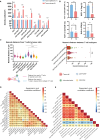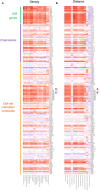Location matters: spatial dynamics of tumor-infiltrating T cell subsets is prognostic in colon cancer
- PMID: 38375478
- PMCID: PMC10875018
- DOI: 10.3389/fimmu.2024.1293618
Location matters: spatial dynamics of tumor-infiltrating T cell subsets is prognostic in colon cancer
Abstract
Background: Colon cancer is a heterogeneous disease and consists of various molecular subtypes. Despite advances in high-throughput expression profiling, limitations remain in predicting clinical outcome and assigning specific treatment to individual cases. Tumor-immune interactions play a critical role, with tumors that activate the immune system having better outcome for the patient. The localization of T cells within tumor epithelium, to enable direct contact, is essential for antitumor function, but bulk DNA/RNA sequencing data lacks spatial distribution information. In this study, we provide spatial T cell tumor distribution and connect these data with previously determined genomic data in the AC-ICAM colon cancer patient cohort.
Methods: Colon cancer patients (n=90) with transcriptome data available were selected. We used a custom multiplex immunofluorescence assay on colon tumor tissue sections for quantifying T cell subsets spatial distribution in the tumor microenvironment, in terms of cell number, location, mutual distance, and distance to tumor cells. Statistical analyses included the previously determined Immunologic Constant of Rejection (ICR) transcriptome correlation and patient survival, revealing potential prognostic value in T cell spatial distribution.
Results: T cell phenotypes were characterized and CD3+CD8-FoxP3- T cells were found to be the predominant tumor-infiltrating subtype while CD3+FoxP3+ T cells and CD3+CD8+ T cells showed similar densities. Spatial distribution analysis elucidated that proliferative T cells, characterized by Ki67 expression, and Granzyme B-expressing T cells were predominantly located within the tumor epithelium. We demonstrated an increase in immune cell density and a decrease in the distance of CD3+CD8+ T cells to the nearest tumor cell, in the immune active, ICR High, immune subtypes. Higher densities of stromal CD3+FoxP3+ T cells showed enhanced survival outcomes, and patients exhibited superior clinical benefits when greater spatial distances were observed between CD3+CD8-FoxP3- or CD3+CD8+ T cells and CD3+FoxP3+ T cells.
Conclusion: Our study's in-depth analysis of the spatial distribution and densities of major T cell subtypes within the tumor microenvironment has provided valuable information that paves the way for further research into the intricate relationships between immune cells and colon cancer development.
Keywords: T cell; colon cancer; immunologic constant of rejection; multiplex immunofluorescence; spatial analysis; tumor microenvironment.
Copyright © 2024 Zhu, Roelands, Ahmed, Stouten, Hoorntje, van Vlierberghe, Ijsselsteijn, Lei, de Miranda, Tollenaar, Vahrmeijer, Bedognetti, Hendrickx and Kuppen.
Conflict of interest statement
DB reports employment with Kite, a Gilead Company. The remaining authors declare that the research was conducted in the absence of any commercial or financial relationships that could be construed as a potential conflict of interest.
Figures





Similar articles
-
Intraepithelial effector (CD3+)/regulatory (FoxP3+) T-cell ratio predicts a clinical outcome of human colon carcinoma.Gastroenterology. 2009 Oct;137(4):1270-9. doi: 10.1053/j.gastro.2009.06.053. Epub 2009 Jul 3. Gastroenterology. 2009. PMID: 19577568 Free PMC article.
-
Prognostic impact of FoxP3+ regulatory T cells in relation to CD8+ T lymphocyte density in human colon carcinomas.PLoS One. 2012;7(8):e42274. doi: 10.1371/journal.pone.0042274. Epub 2012 Aug 6. PLoS One. 2012. PMID: 22879926 Free PMC article.
-
Intertumoral Heterogeneity of CD3+ and CD8+ T-Cell Densities in the Microenvironment of DNA Mismatch-Repair-Deficient Colon Cancers: Implications for Prognosis.Clin Cancer Res. 2019 Jan 1;25(1):125-133. doi: 10.1158/1078-0432.CCR-18-1984. Epub 2018 Oct 9. Clin Cancer Res. 2019. PMID: 30301825 Free PMC article.
-
The prognostic value of tumor-infiltrating lymphocytes in colorectal cancer differs by anatomical subsite: a systematic review and meta-analysis.World J Surg Oncol. 2019 May 22;17(1):85. doi: 10.1186/s12957-019-1621-9. World J Surg Oncol. 2019. PMID: 31118034 Free PMC article.
-
Spatial analyses of immune cell infiltration in cancer: current methods and future directions: A report of the International Immuno-Oncology Biomarker Working Group on Breast Cancer.J Pathol. 2023 Aug;260(5):514-532. doi: 10.1002/path.6165. Epub 2023 Aug 23. J Pathol. 2023. PMID: 37608771 Free PMC article. Review.
Cited by
-
Association between somatic microsatellite instability, hypermutation status, and specific T cell subsets in colorectal cancer tumors.Front Immunol. 2024 Dec 23;15:1505896. doi: 10.3389/fimmu.2024.1505896. eCollection 2024. Front Immunol. 2024. PMID: 39763680 Free PMC article.
-
Colon Cancer Disease Diagnosis Based on Convolutional Neural Network and Fishier Mantis Optimizer.Diagnostics (Basel). 2024 Jul 2;14(13):1417. doi: 10.3390/diagnostics14131417. Diagnostics (Basel). 2024. PMID: 39001307 Free PMC article.
-
Density of T-cell Subsets in Colorectal Cancer in Relation to Disease-Specific Survival.Cancer Epidemiol Biomarkers Prev. 2025 Jul 1;34(7):1122-1133. doi: 10.1158/1055-9965.EPI-25-0287. Cancer Epidemiol Biomarkers Prev. 2025. PMID: 40243533
References
-
- Ishibe A, Watanabe J, Suwa Y, Nakagawa K, Suwa H, Misumi T, et al. . A prospective, single-arm, multicenter trial of diverting stoma followed by neoadjuvant chemotherapy using mFOLFOX6 for obstructive colon cancer: YCOG 1305 (PROBE study). Ann Surg (2022) 276(1):140–5. doi: 10.1097/SLA.0000000000004494 - DOI - PubMed
-
- Amin MB, Greene FL, Edge SB, Compton CC, Gershenwald JE, Brookland RK, et al. . The Eighth Edition AJCC Cancer Staging Manual: Continuing to build a bridge from a population-based to a more "personalized" approach to cancer staging. CA Cancer J Clin (2017) 67(2):93–9. doi: 10.3322/caac.21388 - DOI - PubMed
Publication types
MeSH terms
Substances
Associated data
LinkOut - more resources
Full Text Sources
Research Materials

